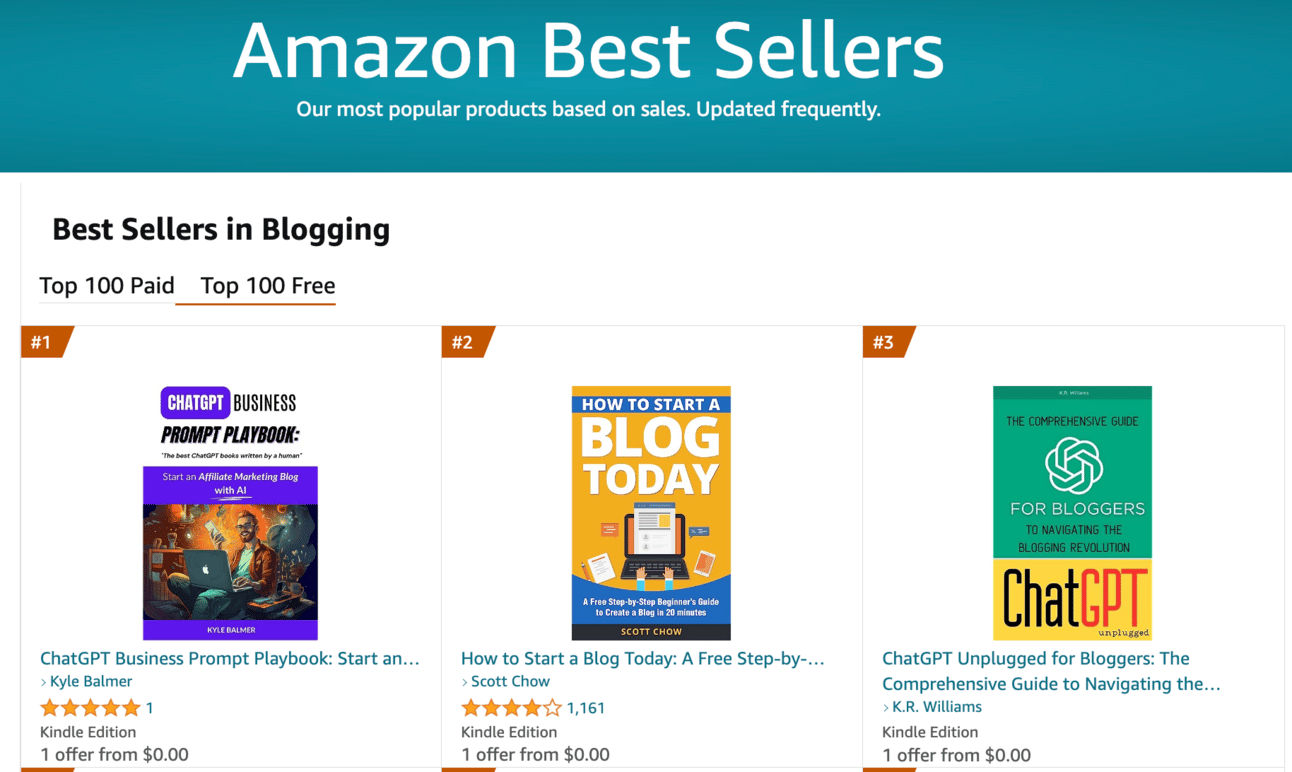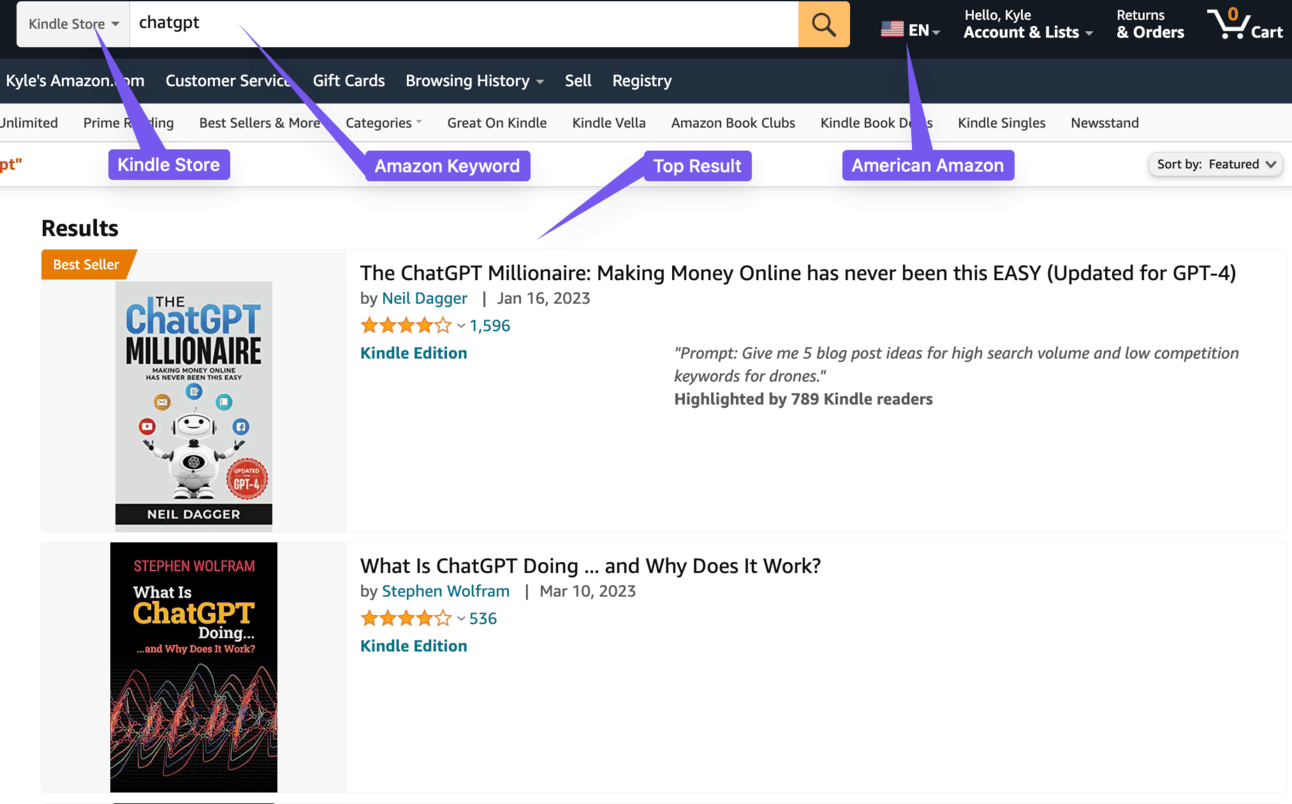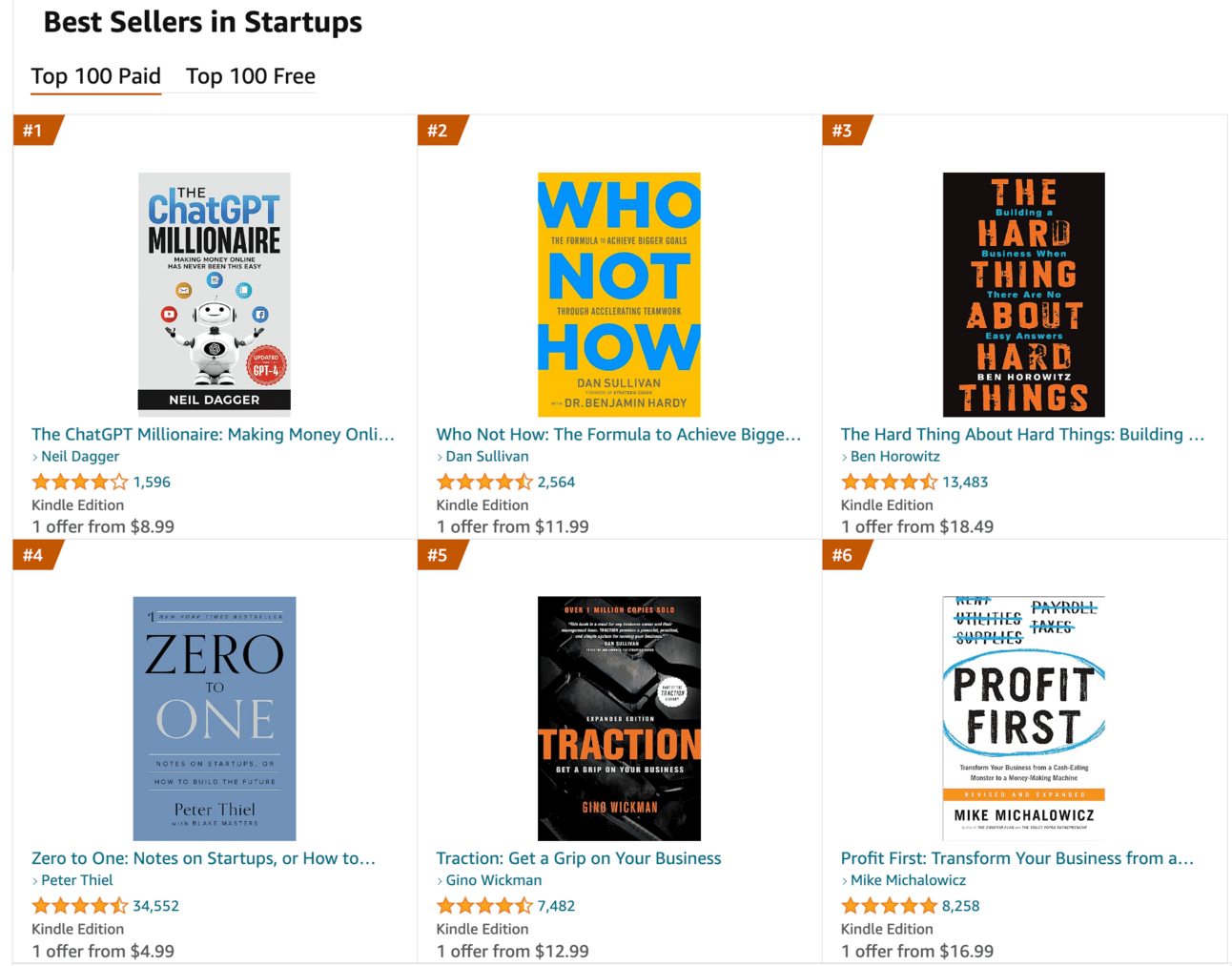Hey Prompt Entrepreneur,
This week we’re going to dive into the world of Kindle Direct Publishing or KDP.
Twitter was close though so I’ll probably do that in an upcoming week too!
So what’s Kindle Direct Publishing (KDP) when it’s at home then eh?
Ever since these bad-boys have been around Publishers have ruled the roost.

To publish a book you had to get a publisher interested in your book. This was because to make publishing profitable huge volumes of books would need to be printed at the same time. This reduced the cost per book and made it profitable to publish.
This basically excluded most authors and book ideas – if your book wasn’t a near guarantee to sell thousands and thousands of copies a publisher wasn’t going to touch you.
Hell, even J.K. Rowling was denied by 12 publishers before going on to publish the world’s most successful book series.
Amazon changed that.
Amazon (specifically CreateSpace, a company that Amazon purchased) flipped the model by allow authors to directly self-publish via Amazon.
Basically you can now give Amazon a Word document and when someone buys your book they’ll “print on demand” a single copy of the book and send it to the buyer.
No need to have a publishing run of 10,000 books, all pre-paid for and printed. Each book purchased means one copy printed.
This ease of access was expanded by Amazon Kindle. Now the book doesn’t even have to be printed on paper – it can just be digitally delivered to the customer’s Kindle.
This has opened the flood gate meaning that anyone can publish to Amazon. Amazon calls this service Kindle Direct Publishing (KDP).
For example my Prompt Playbooks are published on Amazon in both paperback and Kindle formats and rank as best sellers:

My affiliate blog book sitting at #1 in the Blogging category.
This is a powerful way to both get your message out and build your brand.
And to generate passive income via constant sales.
This week we’re going to be doing a deep dive into how exactly to:
Part 1: Decide your book topic
Part 2: Plan your book
Part 3: Write your book
Part 4: Publish your book
Part 5: Market your book
Let’s get started:
Decide your book topic
1. Brainstorm potential book topics
We are going to be using AI to assist us in writing our book.
We are not however going to have AI write the whole thing. Whilst this is possible the end result will be low quality.
Use this prompt to get started:
Act as a book writing coach.
I am about to write an eBook and need topic suggestions.
Sequentially ask me the following questions, one at a time. Collect my answers.
What are your passions or hobbies?
What are you naturally good at?
What experiences have significantly shaped your life?
What are some topics you always find yourself reading or learning about in your free time?
Are there any subjects you often explain to others or help others with?
What do people frequently ask for your advice on?
What areas do you feel are misunderstood or inadequately covered by existing literature?
What is a topic you would be willing to spend a significant amount of time researching and exploring in depth?
Have you noticed any common challenges or problems people around you face?
If you were to teach a course or seminar, what would it be about?
At the end of the questions use the information you have gathered to generate 10 potential topics that I could write about. Make them diverse to give me a range of options. For each also provide a keyword that describes the topic.Prompt Output 💬

This will spit out a handful of topics and (importantly) a seed keyword. We’ll be using this keyword in the next step as we start to look at Amazon keywords.
For now pick out the ones you like the look of. Need more? Ask ChatGPT to generate more potentials. This should give you more than enough to work with.
2. Finding your keyword
Amazon is a big place with a LOT of books.
We need to rise above the rest. We do this i) by having a kick-ass book but also ii) making sure we are competing in a topic that makes sense.
Our topic is determined by our keywords (what people type in search in order to find us) and our Category (what we categorise ourself as using Amazon’s built in categories).
We’ll look at keywords first.
If you have access to a (paid) keyword tool then all the research steps in the rest of this Part can be done easily. I’m writing this guide so that anyone can perform the process so using manual methods.
In the previous step ChatGPT will have given you some starter keywords. For the topics you are interested in head to this tool:
Amazon Keyword Tool – Find Amazon Keywords for Free
www.keywordtooldominator.com/k/amazon-keyword-tool
Set Amazon Department to “Kindle Store” and leave country as USA as it’s the largest Amazon market.
Here are the results for the keyword “ChatGPT”

The Score is how popular the search term is.
Go ahead and note down the top 10 Amazon keywords you get from each seed keyword.
So for example from the seed keyword “ChatGPT” I now have the Amazon keywords “chatgpt millionaire”, “chatgpt prompts”, “chatgpt for dummies”, “chatgpt book” etc.
I suggest you remove specific book names and brand names. These are searches people are performing because they are looking for a specific book – and not your book.
So in this example I’d remove “chatgpt millionaire”, “chatgpt for dummies” and “chatgpt bible” which are all specific books. That leaves me instead with “chatgpt prompts”, “chatgpt book”, “chatgpt for beginners” etc.
Do this for each of your potential topics, keeping record of the potential Amazon keywords for each topic. The more topics the more seed keywords and the more Amazon keywords. So to cut down your workload focus on the topics that you are really interested in.
3. Finding Categories
We’re now going to take the lists of Amazon keywords (ie. “chatgpt prompts”, “chatgpt book”, “chatgpt for beginners”) and find our Categories.
Categories are pre-existing hierarcies that Amazon uses to sort its books. We want to find a category that is i) popular and ii) has low competition.
Open up an Anonymous/Private browser. In Chrome this is File > New Incognito Window. This is so our previous Amazon browsing history does not seep into our results.
Now up head to to amazon.com, the US version of Amazon.
Why use the American version? Because we are writing a Kindle book it will be available on all the regional Amazon platforms – UK, France, Brazil, Japan etc.
But US Amazon is the largest single market and will give us the largest platform- therefore it’s critical we do well on US Amazon.
Plug in one of your keywords and set search to Kindle Store:

Note: ignore any books that say “Sponsored”. These are not organic placements – they are there because the author is paying for ads.
The top result here is a book called “The ChatGPT Millionaire”. There’s no Sponsored tag next to this listing so it’s really #1 for this term.
#2 is Stephen Wolfram’s “What is ChatGPT Doing…and Why Does It Work?” – an excellent book by the way if you want to know more about the mechanics of AI. The next listings are #3, #4 etc.
Go ahead and open up #1 and find this section of the page:

We’re interested in the Best Seller Rank and the categories here.
This shows me that this book is #1 in Startups, Neural Networks and Computer Neural Networks. These are Amazon categories.
We can click on the name to see the list of books under this category.
Here’s the results for Startups:

On this same page you can also see the hierarchy of Categories:

Here you can see the hierarchy is Kindle Store > Kindle eBooks > Business & Money > Business Development & Entrepreneurship > Startups
Generally the further down the hierarchy the category is the more niche. For example Startups is a sub-category of Business Development & Entrepreneurship which it itself a subcategory of Business & Money.
We will not (initially!) be able to get a best seller in a master category like Business & Money. It’ll be too competitive and be full of books with professional publishers, brand recognition and marketing budgets.
A quick check shows that particular category has the likes of The 7 Habits of Highly Effective People. We’re not going to take on that level of competition. Yet!
Instead we’re looking for these sub-sub categories like Startups.
The task for now is:
- For each Amazon keyword
- Perform and search and get details on the top 5 books per keyword
- For each book collect the 3 categories
- Save the links
You’ll find there is overlap. For example #2 (Stephen Wolfram’s book) also appears in Neural Networks and Computer Neural Networks. An overlap of 2/3.
Once you’ve collected up all the categories we’ll move on to narrowing down to our target category.
4. Choosing a category
Now we’re going to analyse each of our potential categories and choose our target category.
We’ll do this by working out the relative i) popularity of the category and ii) the competition within the category.
We want to find a category with high popularity and low competition. This will be our best target category.
Now comes the art of the process. We’re going to have to use a little judgement here! Unless you have paid research tools!
If you have access to paid tools this is definitely the place you want to be using them. I personally use KDSpy. Here’s what it looks like in action.

KDSpy will take your keywords or categories and tell you the total sales, the popularity of the topic, the competition and the potential for revenue. It uses a traffic light system (in the bottom right) to make it easy – red is unattractive, green is great niche.
Here you’ll see a niche with ~$10m of monthly revenue, green light for popularity and potential and red light for competition – ie. this is an extremely attractive niche but there’s stiff competition.
Because KDSpy (and similar tools) are paid I want to give you a more manual free method to start with. And when you can justify the investment I’d recommend looking at a paid research tool.
Here’s our manual method.
Start with your first potential category. Make sure you are in US Amazon still.
We want to work out roughly how many books are being sold per month in this category.
Navigate to the first book at find its Best Seller Rank (BSR). It’s just above the 3 categories we collected earlier. Here for example the BSR is #1630 in the Kindle Store.

Head to this calculator website:
Amazon Book Sales Calculator – TCK Publishing
www.tckpublishing.com/amazon-book-sales-calculator

We plug in 1630 and eBook to calculate the number of sales:

This suggests this book is selling 134 copies a day, 2006 per month. Not too surprising considering it is #1 in Startups, a very high traffic category.
We take note of this figure: Category: Startups, #1, 2006 sales.
We then do this for the top 5 books in the category so we end up with the total monthly sales of the top 5 books.
We then repeat this process for each category. At the end of the process we’ll have the total sales volume of the top 5 books for each of our potential categories.
This gives us the first piece of the puzzle: popularity. Remember we are looking for a niche with i) high popularity and ii) low competition.
We now know which of our potential categories is the most popular, and which is the least, based on the total volume of sales. Solid work.
Next part is competition. This is definitely going to be more judgement based unless you use a tool. That’s fine though as we are just looking for the relative best target category out of the potential categories we have.
For each category:
- Check if the top 10 is full of books with 1000s of reviews. If so: it’s too competitive. Seek a narrower sub-category.
- Are there lots of sponsored listings? If so it means it is a very popular niche and people are willing to spend money on ads – this means competition.
- Check the quality of the listing descriptions and the covers. Are there fully fleshed out descriptions and professional quality cover designs? If so that’s a competitive niche.
Conversely
- Lots of books with sub-100 reviews? There’s a space in the market for you.
- Bad reviews on the top books? A good sign you can make headway here.
- Little to no sponsored listings means people aren’t competing for the niche.
- Badly designed covers and poorly written book descriptions means making sales will be easier.
You’ll have to use judgement here. Go through each category looking for these signs and place the category in either High, Medium or Low competition, relative to the other categories.
First time you do this it’ll be a bit faltering but it becomes second nature once you know what to look for.
At the end of this you should have all your potential categories ranked by order of popularity and with a gauge of whether they are high, medium or low competition.
From this you need to decide your primary category. Go for the most popular one you can with Medium or ideally Low competition.
We will be selecting three categories when we publish but for the purpose of planning and writing the book it is best to focus on a single category. So go ahead and choose that category now.
Pulling it together
This has been an in-depth process. But rest assured you’ve just done the most important part of ensuring the success of your Kindle book.
It may have taken a long time to get here but believe me it takes even longer to just write a book blind, publish it and hope for the best. Amazon is littered with millions of such books which languish with one or two sales.
We’re instead using this pre-production to put ourselves in the best position for a best selling book.
Right now, after this process, you should have decided your single category.
In the next parts we’re going to take that target category and plan, write and publish the perfect Kindle book.
A reminder of this week:
Part 1: Decide your book topic
Part 2: Plan your book
Part 3: Write your book
Part 4: Publish your book
Part 5: Market your book
